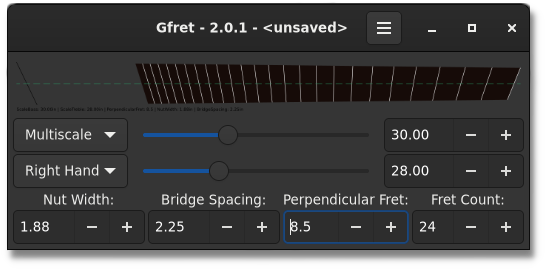Gfret


Contents
Introduction
Gfret renders an svg image template of a fretboard for a stringed instrument. It has a Gtk interface as well as a command line interface and can produce templates for instruments ranging from a piccolo mandolin to an upright bass. Multiscale designs are also supported. Currently, all measurements are expressed in metric units only.
Getting Gfret
Gfret is distributed primarily in source form. The main repo is at codeberg.org with mirrors at gitlab and gibub.com. Releases are recommended.
Usage
Gfret can be used from the command line or using the Gtk+ interface.
Running the command line interface
gfret-cli
Output an svg without running the interface
USAGE:
gfret cli [OPTIONS] [OUTPUT]
ARGS:
<OUTPUT> Name of the output file [default: output.svg]
OPTIONS:
-b, --bridge <BRIDGE>
Bridge spacing [default: 56]
-c, --count <COUNT>
Total fret count [default: 24]
-e, --external <EXTERN>
Open output file in external program [default: inkscape]
-h, --help
Print help information
-l, --left
Multiscale fretboard reversed (left handed)
-m, --multi <MULTI>
Creates a multiscale fretboard with <MULTI> as the treble scale. [default: 610]
-n, --nut <NUT>
Nut width [default: 43]
-o, --output <OUTPUT>
Name of the output file [default: output.svg]
-p, --perpendicular <PERPENDICULAR>
Set which fret is perpendicular to the centerline [default: 8]
-s, --scale <SCALE>
Scale length in mm [default: 648]
Running the gui
Calling the program by invoking gfret without any arguments will run
the Gtk interface. Additionally, a .desktop file and icon are included and
will be installed if the program is installed using the included
Makefile, and can be used for launching the program from desktop menus
or creating shortcuts.
Keybindings
| Key | Action |
|---|---|
| Ctrl/S | save file |
| Ctrl/Shift/S | save file as |
| Ctrl/E | open with an external program |
| Ctrl/O | load a template from file |
| Ctrl/Shift/P | open the preferences dialog |
| Ctrl/A | open the about dialog |
| Ctrl/Q | quit the program |
Templates
Along with the svg output, Gfret will save the specifications used to generate the rendering in a Toml file with it's name corresponding to the name of the svg file. These templates can be loaded later, either as an argument when invoking the program, in which case the output will be immediately generated, or else loaded from the Gui interface for further editing. This is useful for sharing a common scale among multiple designs to use as a starting point.
Configuration
On Unix systems the default configuration directory is ~/.config/gfret.
Gfret will maintain a configuration file here in Toml
format, with the following fields:
## must match either "Metric" or "Imperial"
units = "Metric"
## the command line to run
external_program = "inkscape"
## the size of the border around the image
border = 10.0
## how thick the lines are
line_weight = 1.0
[fretline_color]
## Colors must be "Hex", "Reduced" or "RGBA"
## "Reduced" will take a whole number between 0 and 255 for each channel,
## while "RGBA" takes a decimal between 0.0 and 1.0.
## "Hex" will have a <color> field and an <alpha> field
## ColorType = "Hex"
## color = "#00ff00"
## alpha = 1.0
ColorType = "Reduced"
red = <u8>
green = <u8>
blue = <u8>
alpha = <u8>
[fretboard_color]
ColorType = "Reduced"
red = 36
green = 31
blue = 49
alpha = 255
[centerline_color]
ColorType = "Reduced"
red = 0
green = 0
blue = 255
alpha = 255
## Fonts take a family and weight (style), but size is ignored
[font]
family = "Sans"
weight = "Normal"
Note: The graphical interface has a preferences dialog and will take care of maintaining the preferences file for you. There will be no need to edit this file by hand in normal use.
Building
You will need a Rust toolchain installed, including cargo. Gtk+ version 4 is also
required. To build the program, run cargo build --release to build a
release binary in target/release.
Alternatively, you can use the included Makefile to build and install the
program, adjusting the installation path with the PREFIX and DESTDIR variables.
Roadmap
- For the gui, it would be nice to save state and allow loading specs from and saving to templates. partial implementation 4/7/21 | completed 5/5/21
- Port to Gtk4 completed 12/21
- Support changing from metric to imperial measurements completed 12/21
- Support left handed multiscale fretboards completed 12/21